Saturdays, noon to 1 p.m. ET on WICR 88.7 FM.
Or listen live from anywhere on WICR Online!
Our call-in number during the show: (317) 788-3314

August 18, 2018
Weir Cook and Paul Baer, WWI aviators and former airport namesakes
Both were pioneer aviators and heroic World War I fighter pilots from Indiana, and both were killed while flying aircraft overseas.
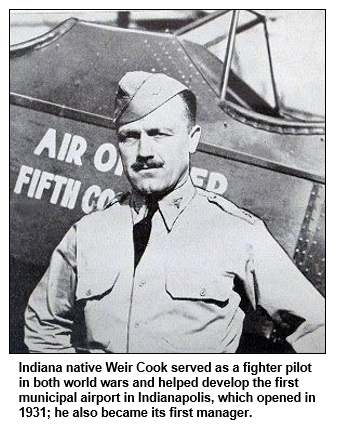
To explore the lives of the aviators who earned national acclaim for their valor during what once was known as the Great War, Nelson will be joined in studio by:
- William Bell, an Indianapolis-based writer and retired law enforcement officer who has researched Hancock County native Weir Cook (1892-1943), who was awarded the Distinguished Service Cross in World War I. Cook also was hailed as a hero during World War II even though he was well into his 40s when he returned to the Army Air Corp and flew combat missions over the Pacific.
- And Tony Garel-Frantzen of Buffalo Grove, Ill., the author of Hoosier Aviator Paul Baer: America's First Combat Ace (The History Press, 2017). In his biography of Baer (1894-1930), Tony contends the Fort Wayne native became the first American to shoot down an enemy plane in combat and the first to earn the title of "combat ace." Tony writes that Baer's historic achievements often have been overlooked because he flew for a French squadron prior to the United States' entry into World War I.
The designation of "combat ace," which both Cook and Baer achieved, is given to pilots who accomplish five aerial victories during warfare.
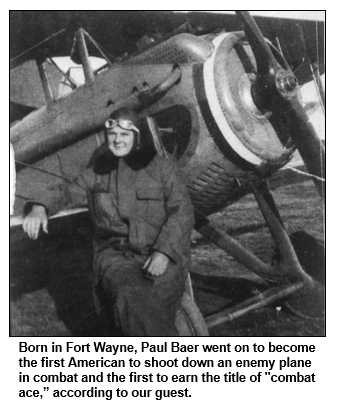
After Cook was killed while flying a combat mission, the Indianapolis airport at Indianapolis was named Weir Cook Airport. In 1976, its name was changed to Indianapolis International Airport, outraging many veterans groups. When the city's newly constructed airport opened at its current site in 2008, the mid-field terminal and the roadway leading to it were named in Cook's honor.
In Fort Wayne, Baer had grown up as a shy but adventure-seeking youth, according to Hoosier Aviator. After France declared war on Germany in 1914, Baer was among a few American volunteers who signed up to fight on the side of the French; America did not declare war until 1917. As a combat pilot, Baer flew missions for both France and the United States.
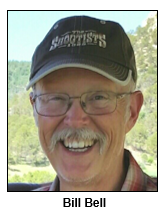
Like Baer, Weir Cook received his initial flight training in France. He had been born Harvey Weir Cook in the small Hancock County town of Wilkinson, where a community park has been named in his honor. Cook grew up in Anderson, graduated from Anderson High School and attended both DePauw University and Washington & Jefferson College before moving to France at the outbreak of World War I.
During the war, Cook downed at least seven enemy aircraft and was promoted to flight commander of the 94th Aero Squadron, a pursuit (fighter) unit of the U.S. Army Air Service. After the war, Cook undertook many roles in the civilian aviation industry and helped bring the first municipal airport to 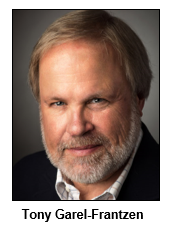
During World War I, Baer achieved his first aerial victory in March 1918, shooting down a German fighter plane while flying for a French squadron. That victory - which was quickly followed by others - made Baer the first U.S. pilot to shoot down an enemy plane in warfare, according to Tony Garel-Frantzen's biography. By mid-April 1918, Baer had felled five enemy planes, making him the first American combat ace, Tony writes.
In May 1918, Baer's plane was shot down. Although he escaped serious injuries, Baer became a prisoner of war and spent time in several German prisons.
"True to his reticent nature," Tony writes, "Baer rarely spoke in detail while he was alive about the day he was shot down or about the months he spent in captivity."
History Mystery
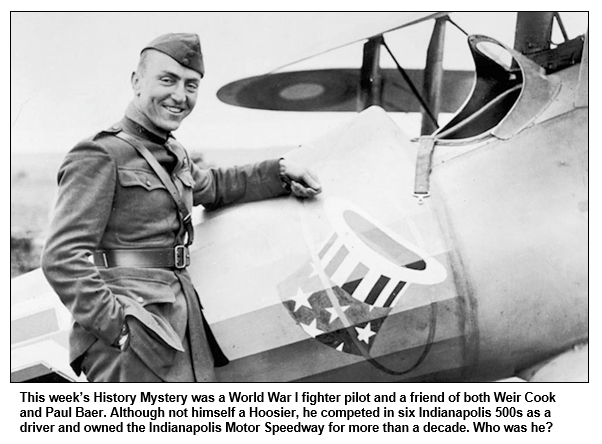
A fighter pilot during World War I who achieved international fame became a friend of both Weir Cook and Paul Baer. The pilot, who eventually was awarded the Congressional Medal of Honor, was not a Hoosier, but he was connected in several ways to Indiana.
As a race driver, he competed in six Indianapolis 500s. He even owned the Indianapolis Motor Speedway for more than a decade.
Question: Who was fighter pilot, Congressional Medal of Honor winner, race car driver and IMS owner?The call-in number is (317) 788-3314. Please do not call in to the show until you hear Nelson pose the question on the air, and please do not try to win if you have won any other prize on WICR during the last two months. You must be willing to give your first name to our engineer, you must answer the question correctly on the air and you must be willing to give your mailing address to our engineer so we can mail the prize pack to you. Prizes are a gift certificate to Story Inn, courtesy of Story Inn, and admission for two to the Indiana History Center courtesy of the the Indiana Historical Society.
Roadtrip: Circle Tower on Indianapolis' Monument Circle
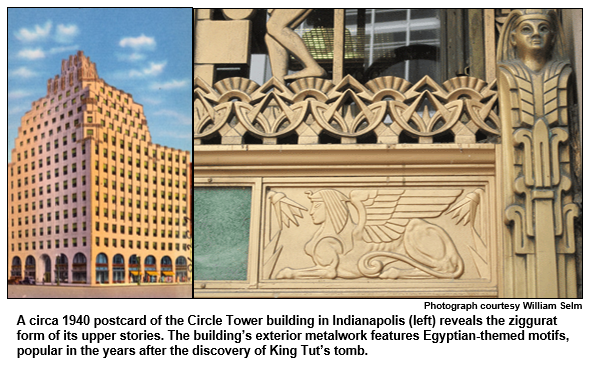
Guest Roadtripper Jim Lingenfelter invites us to join him on a trip to one of the Circle City's most intriguing buildings: the Circle Tower, located on Monument Circle in Indianapolis.
Built in the Roaring Twenties, the Circle Tower radiates the opulence and excess of the period. Marble-lined interior walls, bronze sculptural works on the facade and copious architectural details in the Art Deco style all conspire to convey a sense of wealth and sophistication.
There's a bit of ancient history here as well: constructed during a time when Egyptology was all the rage (King Tut's tomb had just been discovered in 1922), the Indianapolis architecture firm of Rubush and Hunter incorporated copious Egyptian motifs into the building's decor. The bronze grill above the Market Street entrance is replete with hieroglyphic-like imagery that seems to have been borrowed from the walls of a tomb in the Valley of the Kings. The upper stories of the building even have the form of a ziggurat (rectangular stepped tower), evoking an Egyption pyramid.
Jim's interest in the property stretches back before the Circle Tower's construction, however, and is based on a genealogical connection. Direct ancestors of his purchased that quadrant of the Circle in 1831 and by 1835 were operating a boarding house there. "They sold the property in 1873 but continued to live there until 1880 according to City Directories," Jim explains. He'll go into more detail during the show, including the property's years as location of the Franklin Life Insurance headquarters.
Be sure to tune in for this exciting Roadtrip to Egypt by way of Indianapolis!
Post our podcasts, please!
As readers have surely noticed, we are posting links to weekly podcasts of Hoosier History Live at the top of our newsletter and website, generally on the Friday following the live Saturday show. Feel free to copy and paste the links to our podcasts anywhere you connect with others on the Internet. Tweet it to your followers and post it to your FaceBook friends - we love social media! We do request that you not edit or alter the audio files because they contain underwriter credits, and we need their support!
When you do post a podcast link, we appreciate it if you put "Courtesy of Hoosier History Live" and a link to our website www.hoosierhistorylive.org next to the post. As with all media, the more people know about us, the better.
Nelson Price, host and historian
Molly Head, producer/project manager, (317) 927-9101
Michael Armbruster, associate producer
Cheryl Lamb, administrative manager
Richard Sullivan, senior tech consultant
Pam Fraizer, graphic designer
Garry Chilluffo, special events consultant

Please tell our sponsors that you appreciate their support!

 Acknowledgments to Monomedia, Visit Indy, WICR-FM, Fraizer Designs, Heritage Photo & Research Services, Henri Pensis, Chris Shoulders, Aaron Duvall, and many other individuals and organizations. We are an independently produced program and are self-supporting through organizational sponsorship, and by individual contribution at the yellow button on our newsletter or website. For organizational sponsorship, which includes logos, links, and credits in the show, contact Molly Head at (317) 927-9101 or email her at molly@hoosierhistorylive.org. And any of our podcasts can be sponsored for a nominal fee.
Acknowledgments to Monomedia, Visit Indy, WICR-FM, Fraizer Designs, Heritage Photo & Research Services, Henri Pensis, Chris Shoulders, Aaron Duvall, and many other individuals and organizations. We are an independently produced program and are self-supporting through organizational sponsorship, and by individual contribution at the yellow button on our newsletter or website. For organizational sponsorship, which includes logos, links, and credits in the show, contact Molly Head at (317) 927-9101 or email her at molly@hoosierhistorylive.org. And any of our podcasts can be sponsored for a nominal fee.
Thank you!
We'd like to thank the following recent, new and renewal contributors whose donations help make this show possible!
- Dave and Theresa Berghoff
- Ann S. Frick
- Adam Rickert
August 25, 2018 - Upcoming
Ask Nelson - and Keep Indianapolis Beautiful, too

It's time for one of our periodic, all call-in shows during which Hoosier History Live opens the phone lines so listeners can inquire about any aspect of our state's heritage.
Our host, Nelson Price, will be joined by a co-host, civic leader David Forsell, president of Keep Indianapolis Beautiful Inc., the non-profit that's probably best known for partnering with neighborhoods and planting native trees throughout the Hoosier capital.
So this also will be an opportunity for listeners to call in with questions for David. The WICR-FM studio number is (317) 788-3314.
Between phone calls, Nelson and David will interview each other. Nelson plans to ask David about:
- The Crossroads of America motto for Indianapolis that took on a high profile during the 1960s with the construction of the interstate system. In a recent letter to the editor of the Indianapolis Business Journal David Forsell wrote that the design of - and focus on - the interstates "had negative, transformative impacts on city neighborhoods." The issue is timely amid the controversy over plans by the Indiana Department of Transportation to expand and renovate the I-65/I-70 split downtown.
- And the assessment by some critics that litter has become worse in Indy than in other major metro areas. Columns and letters in the Indianapolis Star and the IBJ recently - including some from out-of-state visitors and former residents - have described increasing amounts of debris that detract from the city's rejuvenation.
David Forsell was a studio guest on our show in 2011 about the tree heritage in Indy, including a look at the city's oldest trees and the evolution of the tree canopy.
Also during this show: Because football season already has kicked off, Nelson will share insights about two iconic gridiron figures who are featured in his book Indiana Legends: Famous Hoosiers from Johnny Appleseed to David Letterman:
- To this day, Tom Harmon, who grew up in Gary, Ind., remains the only native Hoosier to have won the Heisman Trophy as the nation's outstanding college football player. Harmon (1918-1990) had an adventure-packed life. As a pilot during World War II, he survived two near-fatal plane crashes; after the war, he became one of the pioneer sportscasters in the early years of TV. Even so, he may be best remembered now as the father of TV and movie actor Mark Harmon.
- And Ara Parseghian, the former University of Notre Dame coach who died last August at age 94. Parseghian devoted his retirement years to crusading for a cure for Neimann-Pick Disorder Type C, a rare, inherited disease that was fatal for several of his grandchildren.
© 2018 Hoosier History Live. All rights reserved.
|






